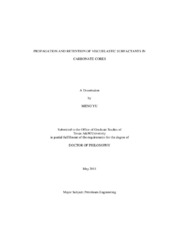| dc.description.abstract | Viscoelastic surfactant have found numerous application in the oil fields as fracturing and matrix acidizing fluid additives in the recent years. They have the ability to form long worm-like micelles with the increase in pH and calcium concentration, which results in increasing the viscosity and elasticity of partially spent acids.
On one hand, concentration of surfactant in the fluids has profound effects on their performance downhole. Additionally, there is continuous debate in the industry on whether the gel generated by these surfactants causes formation damage, especially in dry gas wells. Therefore, being able to analyze the concentration of these surfactants in both live and spent acids is of great importance for production engineers who apply surfactant-based fluids in the oil fields. In the present work, a two-phase titration method was optimized for quantitative analysis of a carboxybetaine viscoelastic surfactant, and surfactant retention in calcite cores was quantitatively determined by two phase titration method and the benefits of using mutual solvents to break the surfactant gel formed inside the cores was assessed.
On the other hand, high temperatures and low pH are usually involved in surfactant applications. Surfactants are subjected to hydrolysis under such conditions due to the existence of a peptide bond (-CO-NH-) in their molecules, leading to alteration in the rheological properties of the acid. The impact of hydrolysis at high temperatures on the apparent viscosity of carboxybetaine viscoelastic surfactant-based acids was evaluated in the present study, and the mechanism of viscosity changes was determine by molecular dynamics (MD) simulations.
Our results indicate that, first, significant amount of surfactant has been retained in the carbonate matrix after acidizing treatment and there is a need to use internal breakers when surfactant-based acids are used in dry gas wells or water injectors. Second, hydrolysis at high temperatures has great impact on surfactant-acid rheological properties. Short time viscosity build-up and effective gel break-down can be achieved if surfactant-acid treatments are carefully designed; otherwise, unexpected viscosity reduction and phase separation may occur, which will affect the outcome of acid treatments. | en |


